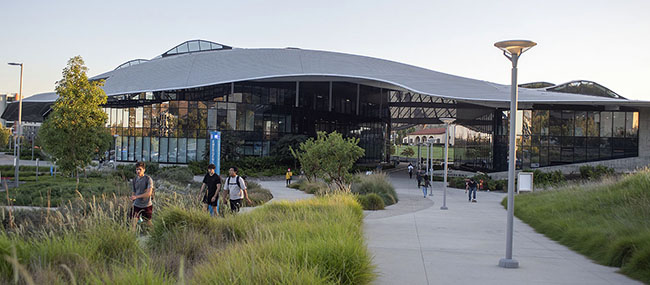How does your garden grow? For CUSD, with ‘more hours’
Community Garden Coordinator Dessa D’Aquila—one of the many district employees on hand at Claremont Unified School District’s annual Food Faire on Wednesday—has some good news.
She will be returning for her second year to help oversee the district’s many gardening projects. The district also is in the midst of turning her position, which was 25 hours per week last year, into a full-time job.
Just as gardening takes time, so does fostering partnerships. Ms. D’Aquila named 3 collaborative efforts as focal points for the coming year.
The first of these is Oakmont’s Biomes Project, in which 4 distinct native environments (desert, grassland, shrubland and forest) are being recreated on the elementary school campus. Each classroom at Oakmont, known as Claremont’s “Outdoor School,” has a significant portion of its curriculum built around these biomes. They are being cultivated via the cooperative efforts of Sustainable Claremont, Bentson & McCallion Water Wise Landscapes and Rancho Santa Ana Botanic Garden.
The community shouldn’t expect instant results, Ms. D’Aquila warned. Native plants can’t be cultivated until around October, when the weather cools down. With some quick work, however, students will soon be able to enjoy a living laboratory aimed at introducing them to the concept of “Earth citizenship.”
Ms. D’Aquila will also be helping Vista del Valle Elementary School as it embraces a free, state-created curriculum called Environmental Education Initiative (EEI). The material is impressive with images provided by National Geographic.
Vista’s gardening niche is its 3 orchards, providing citrus, avocados, guavas, pomegranates and stone fruits like apricots, nectarines and plums. The school will emphasize the sections of EEI curriculum focusing on orchards, and will expand its partnership with the nonprofit Common Vision. The outdoor education organization, which specializes in orchards, sends out representatives each year to prune the trees at schools and to present workshops.
The trees at Vista were pruned on Tuesday and they are absolutely teeming with fruit, noted Vista Principal Dave Stewart, who is excited about the school’s increasing gardening focus.
“It goes along with more hands-on, authentic learning, which is really a movement with the new Common Core standards,” he said.
Ms. D’Aquila’s last area of focus for the upcoming year is the expansion of San Antonio High School’s Food Justice Program. She will be stepping in to lend support to Nancy Neiman Auerbach, a Scripps professor who specializes in food politics and has overseen the program for several years.
This year, the women hope to offer participation in the Food Justice Program to Oakmont and El Roble, with students heading after school to the continuation school campus for a hands-on experience. San Antonio has some 4,000 square feet of garden, D’Aquila estimated, including a fruit orchard and a small native garden.
Food justice means that people everywhere, including urban environments, have regular access to healthy, fresh-grown foods. It’s not just an abstract concept for the students of San Antonio’s Food Justice Program, Ms. D’Aquila asserted. They learn to cook with fresh ingredients and to can and dry produce. They are also regularly sent home with bags of fruit and vegetables, a development by which Ms. D’Aquila is obviously touched.
A growing concern
Adversity helped Ms. D’Aquila find her current avocation. After graduating into an uncertain job market from Vanguard University, Ms. D’Aquila found herself unable to land a job.
With none of her applications panning out, she delved into her hobbies of cooking and gardening and volunteered with nonprofit organizations like Amy’s Farms, which provides guided tours to students in San Bernardino, Los Angeles, Orange and Riverside Counties. She next volunteered with WWOOF-USA (Worldwide Opportunities on Organic Farms), where she spent time working on an organic farm in North Carolina.
When Ms. D’Aquila returned to California, she saw a 2010 documentary on the National School Lunch Program called Lunch Line and was moved to tears at the story of sub-par school food endured by US students, particularly those in poor areas.
While perusing Jamie Oliver’s Food Revolution website, Ms. D’Aquila came across a news item profiling CUSD Nutrition Services Director Rick Cota as a “food revolutionary.” The article praised Mr. Cota for his extraordinary success in moving Claremont schools away from processed food and for the remarkable increase in school lunch participation he has effected.
Intrigued, Ms. D’Aquila contacted Mr. Cota and learned that the district was floating the Community Garden Coordinator job. She applied and the rest is history. Ms. D’Aquila says she is delighted by the bump in hours.
“It’s about taking advantage of all of the resources around us, including the Colleges and volunteers in the community,” she said. “Now, we’re going to have more time to put into that.”
Along with Ms. D’Aquila, hundreds of CUSD students and parents showed up at the Food Faire, sampling foods cooked in Claremont’s Nutrition Center, whipped up by local restaurants and grown on nearby farms.
The National School Lunch Program has new guidelines this year, calling for 2 servings of whole grain per lunch. At this year’s event, attendees tasted double-chicken hotdogs on whole-wheat buns, whole-wheat wraps and tacos grilled by Peters El Loco and served on warm corn tortillas.
Guests were asked to fill out a survey detailing which food made the grade. The nutrition services crew takes the results of the survey seriously, according to Kim Grier, manager of the cafeteria at Sumner Elementary.
“If all the people write down that they don’t like a food, we won’t put it on the menu,” she said.
—Sarah Torribio
storribio@claremont-courier.com










0 Comments